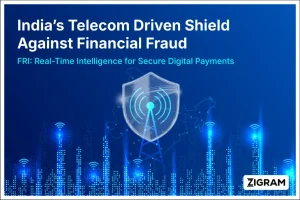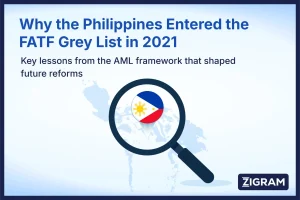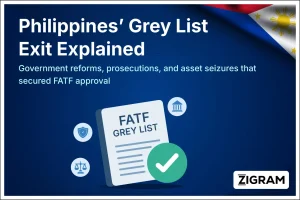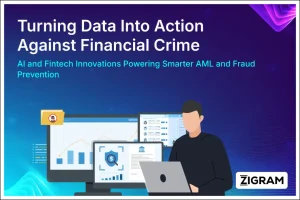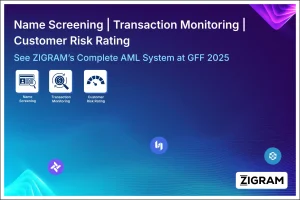Table of Contents
In an era where digital transformation has accelerated financial inclusion, money laundering has evolved into a formidable threat, exploiting the very innovations designed to empower. As banks and fintech companies race to deliver seamless experiences via mobile onboarding and One-Time Passwords (OTPs), holes in Know Your Customer (KYC) protocols increasingly expose them to fraud. What’s often overlooked is the fragility of mobile numbers themselves, its a hidden, high-risk gateway for fraudsters.
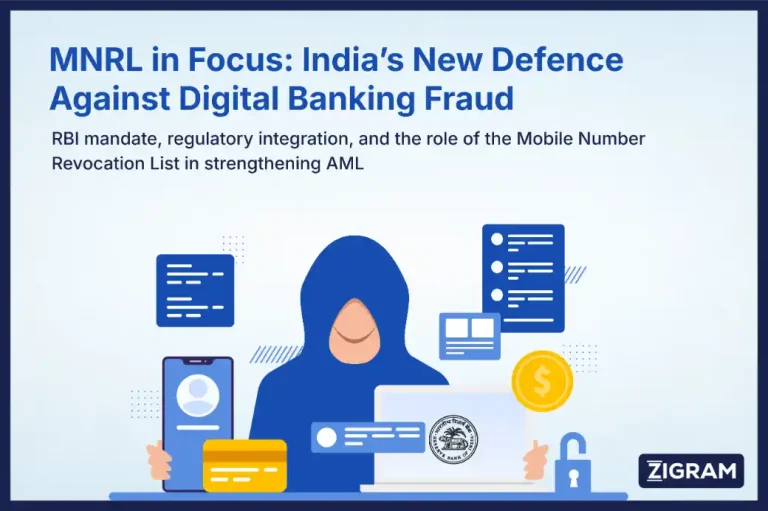
Enter the Mobile Number Revocation List (MNRL) which is a proactive, regulatory-backed registry of disconnected or compromised numbers that stands as a first line of defence against money laundering threats. Mandated by the Reserve Bank of India and delivered through the Department of Telecommunications’ Digital Intelligence Platform, the MNRL enables financial institutions to screen and sanitise their mobile number databases before they become enablers of fraud.
This article equips banks and fintechs with the knowledge they need to:
- Understand why money laundering is a growing challenge, and how mobile number vulnerabilities exacerbate risks;
- Unpack how the Mobile Number Revocation List works, and why it’s not just more than a compliance checkbox but a critical layer in modern AML (Anti-Money Laundering) defences;
- Implement MNRL effectively across onboarding, transaction monitoring, risk-scoring workflows, and fraud prevention strategies.
By rating MNRL as a cornerstone of digital banking risk MITIGATION and AML solutions for banks, we aim to illuminate its transformative power and urge institutions to act now.
Why Money Laundering Is a Rising Threat
The shift to digital banking has been meteoric: banks and fintechs now offer seamless, 24/7 services, driven by mobile-based authentication and rapid onboarding. Yet this convenience has a darker side i.e, money laundering and other financial crimes are escalating, exploiting gaps in Anti-Money Laundering (AML) and Know Your Customer (KYC) frameworks.
Why Money Laundering and Fraud through Mobile Number Is a Growing Challenge
India’s digital payments boom has fueled both inclusion and exposure:
- Cyber fraud incidents jumped from 75,800 in FY 2023 to 2,92,800 in FY 2024, with losses climbing from ₹421.4 crore to ₹2,054.6 crore [5]
- Online and card frauds spiked 425%, involving ₹1,457 crore in FY 24—up from ₹277 crore in FY 23 [6]
- Bank fraud cases surged nearly 300%, from 9,046 in FY 22 to 36,075 in FY 24 [7]
- In the FY 25 period, total fraud value soared to ₹36,014 crore—almost three times higher than the previous year—with digital channels accounting for most incidents [8]
- The first 10 months of FY 25 saw 2.4 million digital fraud cases worth ₹4,245 crore—an uptick from ₹2,537 crore in FY 23 [9]
Mobile Numbers as Vectors of Frauds
- The government deactivated over 7 million mobile numbers due to suspected linkages with fraudulent transactions. This highlights how mobile identities can be weaponised to facilitate financial crime [10]
- In Kerala alone (Jan–Mar 2025), cyber operations led to freezing 18,653 SIM cards and 59,218 mobile/IMEI numbers tied to fraudulent activities [11]
Other challenges:
- Digital transparency vs. anonymity: Virtual transactions allow complex money laundering without physical trails.
- Weak KYC enforcement: Especially in rapid-onboarding fintech models, authentication is often limited to OTPs, making it easier to create mule accounts.
- Regulatory lag: New methods like digital payment wallets and buy-now-pay-later (BNPL) outpace traditional checks.
MNRL: A Powerful Tool to Strengthen AML Defences
Why phone numbers pose a hidden risk: Mobile numbers serve as digital identity proxies until they don’t as SIM swaps, number recycling, or reassignment can instantly redirect OTPs or alerts to unauthorised individuals.
Enter MNRL which is a proactive, regulatory-backed list designed to combat digital banking risk and mobile number fraud. Its purpose is simple yet impactful that prevent fraudsters from exploiting reassigned or suspicious numbers. This article aims to educate banks and fintechs on how MNRL works, why it matters, and how to implement it effectively.
What Is an MNRL? Core Definition & Example
MNRL stands for Mobile Number Revocation List, a registry maintained by telecom authorities (TRAI/DoT) that lists numbers that are disconnected, deactivated, or flagged essentially serving as a mobile number blacklist for AML purposes.
Types of numbers on MNRL include:
- Permanently disconnected or deactivated numbers
- Numbers flagged for fraud or failed re-verification
- Recycled numbers yet to complete safe reallocation
Quick example: A once-registered customer lets their number lapse; the telecom reassigns it. The old number is now in the hands of a fraudster who is able to bypass KYC, receive OTPs, and initiate illicit transactions via a mule account. MNRL helps flag and block this risk.
Why Phone Numbers Are a Weak Link: SIM-Swap, Recycling, AML Risks
Weaknesses in Mobile Numbers
- SIM-swap fraud: Fraudsters transfer a victim’s number to a new SIM, intercepting OTPs and resetting credentials. A real-world case from Mumbai illustrates the severity: a steel trading firm lost a staggering ₹7.5 crore after fraudsters executed a sophisticated SIM swap attack, intercepting One-Time Passwords (OTPs) to drain accounts. Only around ₹4.65 crore was later recovered
- Number recycling: Disconnected numbers are reassigned; prior associations with banks may still link financial services.
- Porting vulnerabilities: During telecom provider switches, reassignments may lapse KYC updates.
Consequences for AML and KYC
- Account Takeover: OTPs or alerts go to new users who are often fraudsters.
- Money Laundering via Mule Accounts: Fraudsters funnel illicit funds through accounts they control with reassigned numbers.
- Bypassing KYC: Weak mobile control undermines identity verification integrity.
How MNRL Helps Prevent These Attacks
- Flags revoked or suspicious numbers before they trigger OTP flows or onboarding.
- Reduces SIM-swap fraud prevention vulnerabilities and account takeover AML risks.
- Helps manage OTP risk and phone number reuse, reinforcing digital banking defences.
MNRL In AML/KYC: From Integration to SLAs, Metrics & Regulatory Considerations
How MNRL Enters Into AML/KYC Workflow
Use Cases Across the Lifecycle
- Onboarding: Validate mobile before KYC to ensure authenticity.
- Password reset or high-value transactions: Block or flag operations on revoked numbers.
- Continuous monitoring: Regular batch or real-time checks on existing customers.
Actions When a Number Is Flagged
Typical workflows:
- Immediate block: Halt SMS/OTP flows.
- Manual review or Enhanced Due Diligence (EDD): Contact customer, reconfirm identity.
- Prompt mobile number update: Engage the customer for updated contact details.
Complementing Other AML Controls
MNRL augments tools like transaction monitoring, geo-analysis, and device fingerprinting. It’s a preventive layer nested in AML use cases for phone number risk in KYC and triggering enhanced due diligence.
MNRL Implementation & Technical Considerations: APIs, Cadence, Accuracy
Implementation Methods
- Manual Download: Banks can download MNRL monthly in formats like JSON, Excel, PDF. [1]
- API Integration: Real-time or periodic access via the Department of Telecommunications’ Digital Intelligence Platform (DIP) [2] [3]
Update Frequency
- Monthly uploads on TRAI portal: earlier method [1]
- Near real-time API via DIP: more immediate and reliable [2]
Integration Into Risk-Scoring Engines
- Add MNRL status as a risk factor: e.g., revoked = block or EDD.
- Combine with other risk indicators—transaction volume, geolocation patterns—for comprehensive scoring.
Handling False Positives & Conflicts
- MNRL includes deactivated numbers that may later be reactivated [1]
- Always conduct customer verification before taking action on the flagged numbers.
- Implement fallback processes for ambiguous or conflicting statuses.
Data Quality, Privacy & Regulatory Considerations
Data Sources
- MNRL is compiled from Telecom Service Providers (TSPs) via TRAI/DoT [1]
Aggregated via DIP with inputs from telecom operators.
Reliability Issues
- Monthly static lists risk latency; near real-time APIs offer higher data freshness.
- Some numbers may be incorrectly flagged or reactivated—handle carefully.
Privacy, Data Retention, and Compliance
- MNRL data does not include personal identity—only numbers, mitigating GDPR concerns
- Yet, the use of MNRL needs audit logging, retention policies, and must align with local privacy laws.
- Commercial responsibility lies with the user agency; TRAI provides no liability for misuse. [1]
Cross-Border Data Issues
- MNRL is India-specific; cross-border institutions must note limited coverage.
- Foreign banks operating in India should still integrate MNRL for local accounts.
Operationalizing MNRL: Ownership, SLAs, Metrics & Business Case
Internal Ownership
- Compliance, Fraud, Risk, and Product teams should collaborate on ownership:
- Compliance monitors regulatory adherence.
- Risk analyses usage impact.
- Product integrates MNRL in user flows.
- Fraud responds to flagged cases.
Reliability Issues
- Expect near real-time API updates via DIP (sub-24h latency)
- Coverage: includes disconnected, fraudulent, reactivated numbers
- Accuracy: proactive re-verification capabilities to reduce stale flags
KPIs to Measure Effectiveness
- Reduced fraud incidence: drop in account takeover or mule activity linked to revoked numbers.
- Improved onboarding integrity: fewer KYC mismatches or fraud attempts.
- Operational efficiency: blocked attempts via flagged numbers versus manual checks avoided.
Example: ZIGRAM AML Platform Integration
- ZIGRAM’s “Complete AML System” integrates MNRL APIs via DIP, automating mobile screening in onboarding and high-risk transactions.
- When a number is flagged, ZIGRAM automatically triggers risk rating workflows, alerts fraud teams, and prompts customer outreach whereby improving detection and response speed.
Why Financial Institutions Should Act Now
- Regulatory Deadline: RBI mandated MNRL integration by March 31, 2025 [2] [4]
- Serious Penalties: Non-compliance may result in telecom service suspension, blacklisting, fines, or legal action [4]
- Fraud Amplification: Risks of money mule operations, AML gaps, and reputational damage are too high.
- Competitive Advantage: MNRL compliance fosters customer confidence, operational resilience, and regulatory goodwill.
Conclusion & Call to Action
The Mobile Number Revocation List (MNRL) is more than a compliance checkbox, it’s a vital shield against SIM-swap fraud, account takeover, and mobile-centric money laundering. By integrating MNRL into onboarding, password resets, high-risk transactions, and your risk-scoring engines, banks and fintechs can significantly bolster their AML solutions for banks and digital safeguards.
Action Steps
- Choose between manual vs API-powered MNRL integration.
- Define SOPs for flagged numbers: block, EDD, customer reach-out.
- Assign responsibilities across compliance, fraud, risk, and product teams.
- Set KPIs to track effectiveness: fraud reduction, onboarding security, ROI.
Bibliography
1) “FAQs on MNRL” – (TRAI)
2) “Mobile Number Revocation List (MNRL) API Explained – Digitap” – (The BFSI Brief)
3) “Stay Compliant with RBI’s Mobile Number Revocation List (MNRL)Mandate Using Perfios MNRL API” – (Perfios)
4) “Cyber frauds on RBI’s radar: Banks mandated to use TRAI’s MNRL technology by March 31, 2025” – (The Economic Times)
5) “Cyber fraud in banking transactions surges in FY24: Data” – (The Hindu)
6) “Card, online frauds surge 5x to Rs 1.5k crore in FY24: RBI” – (The Times of India)
7) “Bank frauds jump nearly 300% in 2 years, amount involved halved: RBI” – (ETBFSI.com)
8) “Bank fraud amount jumps by three times to Rs 36,014 crore in FY25: RBI” – (The Indian Express)
9) “Indians lose Rs 4,245 crore in 24 lakh digital fraud cases in first 10 months of FY25” – (ETBFSI.com)
10) “Govt suspends 7 million mobile numbers due to suspicious transactions” – (Business Standard)
11) Special Drive to help online fraud victims (The Times of India)
- #GENIUSAct
- #Stablecoins
- #AML
- #FinancialCrime
- #Compliance
- #CryptoRegulation
- #FinCEN
- #SanctionsCompliance
- #RegTech
- #AntiMoneyLaundering
- #DigitalAssets
- #FinancialSecurity

